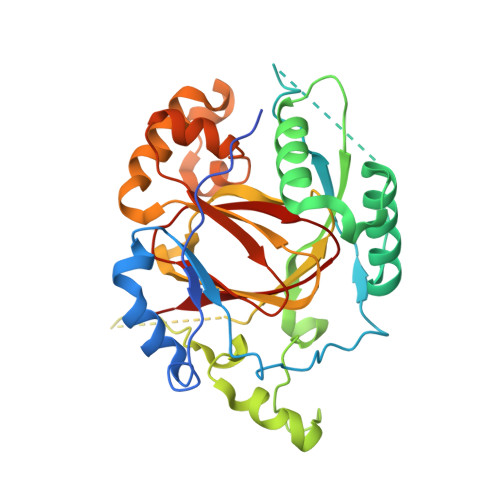Characterization of a Linked Jumonji Domain of the KDM5/JARID1 Family of Histone H3 Lysine 4 Demethylases.
Horton, J.R., Engstrom, A., Zoeller, E.L., Liu, X., Shanks, J.R., Zhang, X., Johns, M.A., Vertino, P.M., Fu, H., Cheng, X.(2016) J Biol Chem 291: 2631-2646
- PubMed: 26645689
- DOI: https://doi.org/10.1074/jbc.M115.698449
- Primary Citation of Related Structures:
5E6H - PubMed Abstract:
The KDM5/JARID1 family of Fe(II)- and α-ketoglutarate-dependent demethylases remove methyl groups from tri- and dimethylated lysine 4 of histone H3. Accumulating evidence from primary tumors and model systems supports a role for KDM5A (JARID1A/RBP2) and KDM5B (JARID1B/PLU1) as oncogenic drivers. The KDM5 family is unique among the Jumonji domain-containing histone demethylases in that there is an atypical insertion of a DNA-binding ARID domain and a histone-binding PHD domain into the Jumonji domain, which separates the catalytic domain into two fragments (JmjN and JmjC). Here we demonstrate that internal deletion of the ARID and PHD1 domains has a negligible effect on in vitro enzymatic kinetics of the KDM5 family of enzymes. We present a crystal structure of the linked JmjN-JmjC domain from KDM5A, which reveals that the linked domain fully reconstitutes the cofactor (metal ion and α-ketoglutarate) binding characteristics of other structurally characterized Jumonji domain demethylases. Docking studies with GSK-J1, a selective inhibitor of the KDM6/KDM5 subfamilies, identify critical residues for binding of the inhibitor to the reconstituted KDM5 Jumonji domain. Further, we found that GSK-J1 inhibited the demethylase activity of KDM5C with 8.5-fold increased potency compared with that of KDM5B at 1 mm α-ketoglutarate. In contrast, JIB-04 (a pan-inhibitor of the Jumonji demethylase superfamily) had the opposite effect and was ~8-fold more potent against KDM5B than against KDM5C. Interestingly, the relative selectivity of JIB-04 toward KDM5B over KDM5C in vitro translates to a ~10-50-fold greater growth-inhibitory activity against breast cancer cell lines. These data define the minimal requirements for enzymatic activity of the KDM5 family to be the linked JmjN-JmjC domain coupled with the immediate C-terminal helical zinc-binding domain and provide structural characterization of the linked JmjN-JmjC domain for the KDM5 family, which should prove useful in the design of KDM5 demethylase inhibitors with improved potency and selectivity.
Organizational Affiliation:
From the Departments of Biochemistry.

















